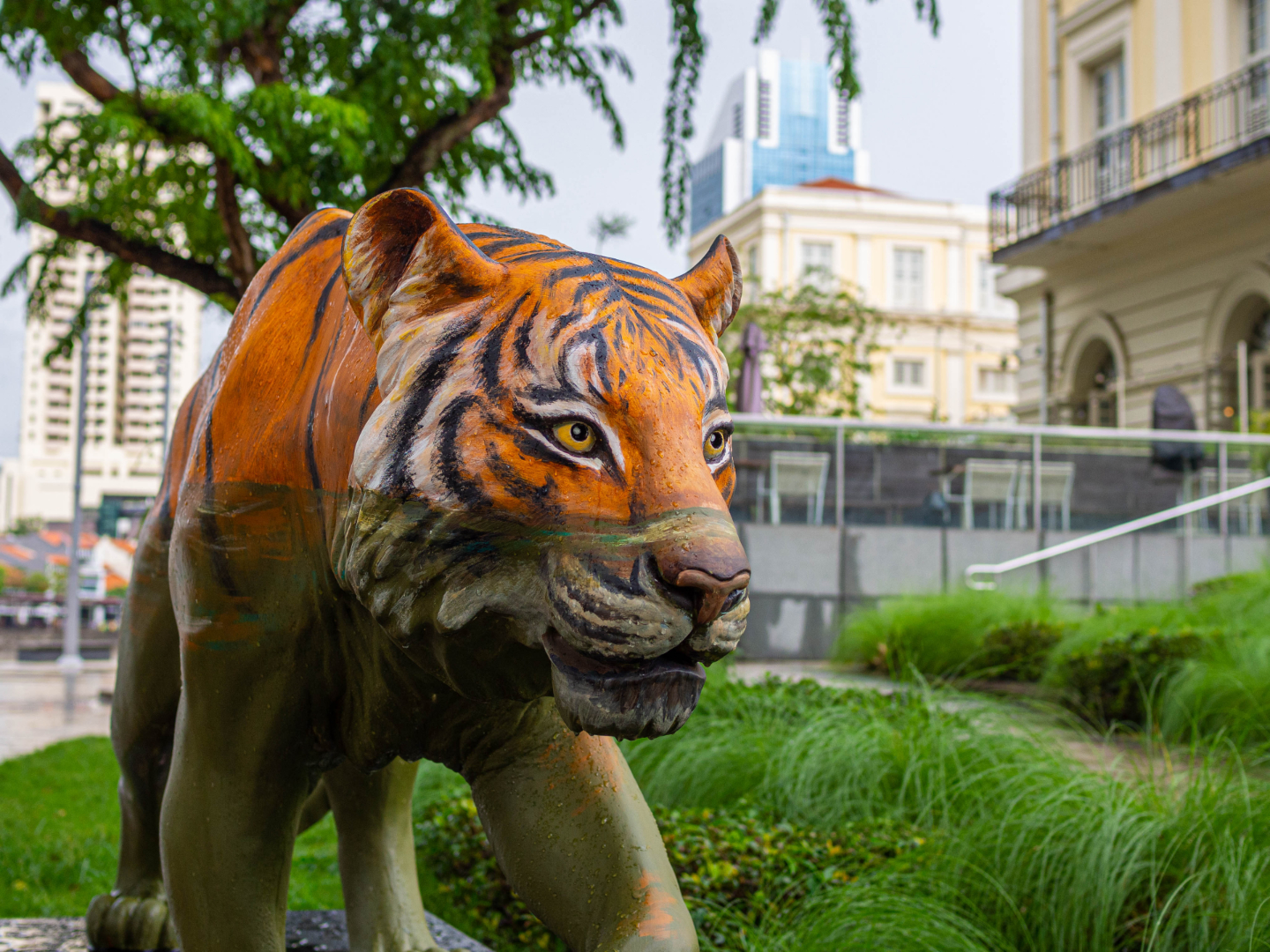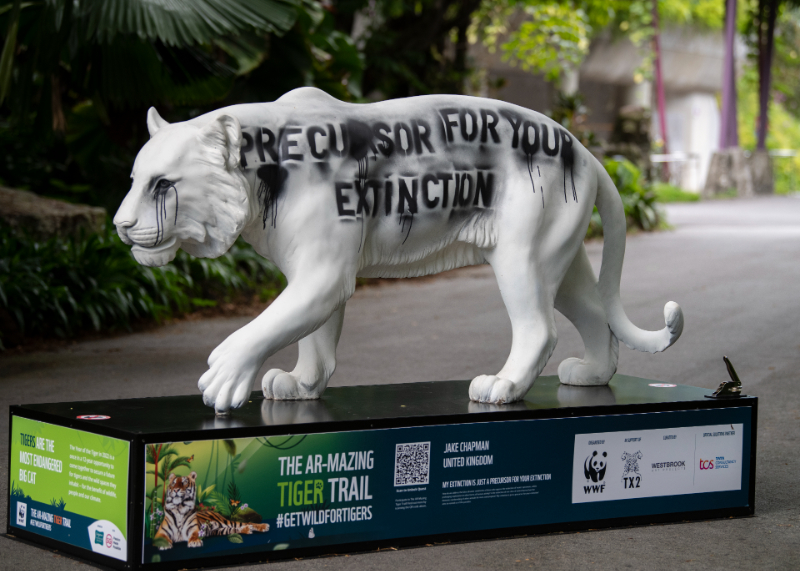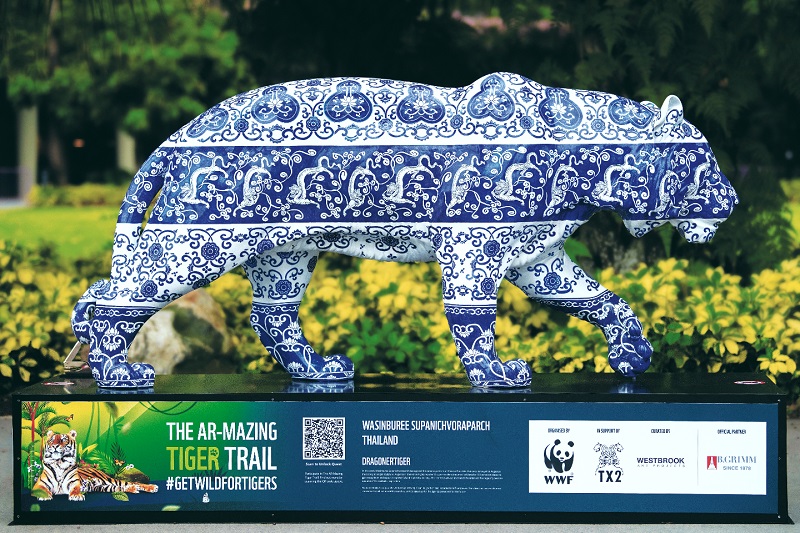
Tiger sculpture by Yip Yew Chong (Photo: Georges Nader)
Whether you say it with flowers, stripes, skulls, stars or words, the message is the same: We must protect tigers before they become extinct. That was the echoing cry over six weeks in Singapore, where life-sized tiger sculptures placed at various locations brought art and conservation together to raise awareness of the issue.
The World Wide Fund for Nature (WWF) Singapore’s AR-mazing Tiger Trail 2022 exhibition featured 33 sculptures and more than 20 art pieces inspired by those majestic creatures. Unveiled on Feb 26 and on show until April 9, the fine art curated trail was designed to highlight WWF’s work on diversity, sustainability and climate change, through the works of 60 artists from 14 countries.
Marking the conclusion of the trail, WWF, together with Sotheby’s, will launch an online auction from April 12 to May 5. The auction will offer collectors from around the world the opportunity to own one of the incredible, life-sized sculptures that formed the AR-mazing Tiger Trail.
Proceeds raised will support its programmes to protect forest habitats, support field rangers and engage local communities in Southeast Asia where, over the last 25 years, the big cats have disappeared from the wilds in Vietnam, Cambodia and Laos. It warns that the Malayan tiger is at risk of becoming just a memory too.
Around 3,900 wild tigers remain today from the 100,000 that used to roam freely on earth at the start of the 20th century. The depleted numbers are a result of climate change and rampant poaching and habitat loss through deforestation. Only about 5% of the tigers’ range remains, and WWF supports groundwork in regions that are home to about 80% of their fragmented population now.
jake_chapman1_kaustubh_srikanth.jpg

Each of the tiger sculptures is a plea to humans to stop hunting these animals and, instead, help increase their population.
Curator and trail director Chris Westbrook says the established artists were invited for many reasons, but a key element they share is the skill to create playful art that audiences can interact with and relate to.
“Their works have strong performative elements, and each has the ability to communicate ideas in an elegant and thought-provoking manner. Every tiger and artwork you see on the trail has a story to tell, a narrative to guide you to a thought, a question, a musing about what it means to live in a world without tigers.”
Westbrook, who is also founder and creative director of Westbrook Gallery Art Projects, cites, for example, the subtle rare and endangered flowers on Singaporean Ashley Yeo’s sculpture, which suggest that protecting tigers helps secure the survival of a wider biodiverse landscape and ecosystem that benefits us all.
Smoke stripes on Nick Gentry’s tiger imply a narrow escape from a harrowing violent end as forests are burnt to the ground. The UK artist’s other contribution is a striking piece inspired by Jae Jae, the Sumatran tiger he locked eyes with at London Zoo. “Time stood still and it gave me this unique sense of something quite primal and ancient ... as if I had accessed a sacred part of our shared animal roots, fostering an inherent deep respect and admiration for these creatures.”
Bharti Kher and Subodh Gupta’s Puli, the result of a significant first collaboration by the Indian artists, juxtaposes the beauty and importance of preserving ritual, history and cultural iconography by combining materials such as utensils and the bindi with a tiger head made of fibreglass.
London-born and based Gordon Cheung uses William Blake’s memorable phrase, “fearful symmetry” (from the poem The Tyger), as the title of his sculpture, which captures the animal’s balance and frightening beauty. Orange stripes made from stock market numbers from a financial newspaper and black stripes painted with ink denote capitalism and the erosion of the ecosystem.
Jake Chapman’s white tiger reminds viewers of the interconnectedness between man and beast as it declares: My extinction is the precursor to your extinction. The Rolling Stones guitarist Ronnie Wood, who has created art throughout his musical career, painted a creature crying out against its imminent demise with two words in red on its back: Save Us.
Zhang Huan’s Poppy Tiger is covered with brightly coloured skulls to convey coexistence between humans and nature. These skeletal elements, symbolic of the patron gods in Tibetan culture, “are spirits representing every life entity and life cell from the universe”, the Chinese artist believes.
Syria’s Sara Shamma laments that humans dry the jungle of its inhabitants, the way they squeeze an old rug. “Then we cover our sins with fake statements and conventions about the environment. One day, the paint will wipe off and the jungle will be nude as an old dream.”
wasinburee1_kaustubh_srikanth.jpg

Bhutan’s Zimbiri finds inspiration from the bold, black stripes that give the tiger its magnificent identity. Her sculpture, Pre-Mythical, has stripes that appear to be stripping off, a foreboding that “these beautiful beasts’ existence may become more mythical than real”.
Thailand’s Wasinburee Supanichvoraparch presents Dragonertiger in the form of an old antique found in a museum, using patterns of Chinese porcelain that once belonged to Polish king Augustus the Strong (1670-1733). Wildlife trades, common in old Siam, are illegal today, but people continue to hunt tigers to sell and for their various benefits, fanning fear that they might disappear and remain only as a part of history.
Mauro Perucchetti’s bright red tiger symbolises luck and joy, but this regal species is at the mercy of man, who humiliates and tortures it. Life is not a circus, the Italian pop artist cautions.
Westbrook observes that as we go about our lives each day, we individually leave a mark on the critically endangered tiger.
“Our ‘footprint’ creates causal reverberations beyond our immediate field of vision. We impact carbon emissions, climate change, deforestation and loss of habitat, and ultimately bear witness to these causalities as we see species such as the tiger critically decline in numbers. Such is our collective responsibility to one another, to our co-habitation with other species and biodiversity, that awareness and dialogue are critical to our future.
“Art has the ability to remind us of these footprints. It breaks down barriers, makes people react, feel and think. Harnessing the emotional and communicative power of art to raise awareness and create positive change culminated in the WWF Tiger Trail. By saving just one tiger, we help preserve over 23,000 acres of carbon capture biodiversity that helps us all.”
Take part in the auction here.
This article first appeared on Apr 11, 2022 in The Edge Malaysia.


